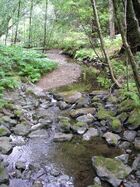Thalweg
Topic: Earth
 From HandWiki - Reading time: 5 min
From HandWiki - Reading time: 5 min
In geography, hydrography, and fluvial geomorphology, a thalweg or talweg (/ˈtɑːlvɛɡ/) is the line or curve of lowest elevation within a valley or watercourse.[1] Its vertical position in maps is the nadir (greatest depth, sounding) in the stream profile.
Under international law, a thalweg is instead taken to be the middle of the primary navigable channel of a waterway that is the default legal presumption for the boundary between entities such as states.[2][3] Thalwegs can have local proprietorial and administrative significance because their formerly somewhat shifting position, reliant on renewed soundings, now more fixed as described internationally, is part of centuries-old custom and practice in some jurisdictions. In some jurisdictions and between some states the median line (between banks) is the preferred boundary presumption as may extend from estuaries. Thirdly, easy to map, drawing "turning points" are the solution for a few major rivers such as the St Lawrence River-Great Lakes system.[4]
Etymology
The word thalweg is of 19th-century German origin. The German word Thalweg (modern spelling Talweg) is a compound noun that is built from the German elements Thal (since Duden's orthography reform of 1901 written Tal) meaning valley (cognate with dale in English), and Weg, meaning way. It means "valley way" and is used, with its modern spelling Talweg, in daily German to describe a path or road that follows the bottom of a valley, or in geography with the more technical meaning also adopted by English.
Hydrology
In hydrological and fluvial landforms, the thalweg is a line drawn to join the lowest points along the length of a stream bed or valley in its downward slope, defining its deepest channel. The thalweg thus marks the natural direction (the profile) of a watercourse.
The term is also sometimes used to refer to a subterranean stream that percolates under the surface and in the same general direction as the surface stream.
Bouldering of thalweg of non-canalised rivers
Slowing stream-bed erosion by bouldering a thalweg helps stabilize natural rivers' course and depth. Placing boulders along the thalweg helps to protect the channel's sedimentary erosion and deposit balance. In concurrence with this, doing so along an instream to form artificial sills helps to slow the sedimentary erosion and deposit of watercourses, while keeping the esteem (fishing, local wildlife, and recreation) and natural resources[5] of the running water source intact. Placement of boulders along a thalweg and the creation of instream sills makes drying up rarer and less severe during late summer, and abates cases of severe sediment erosion and deposit in the spring and fall months when the flow rates are high, particularly if those rates have increased. Such partial infilling of a thalweg was prototyped in Meacham Creek in Umatilla, Oregon.[6]
Thalweg principle
The thalweg principle (also known as the thalweg doctrine or the rule of thalweg) is the legal principle that if the boundary between two political entities is stated to be a waterway, without further description (e.g., a median line, right bank, eastern shore, low-tide line, etc.), the boundary follows the thalweg of that watercourse. Such thalweg is the center of the principal navigable channel of the waterway (which is presumed to be the deepest part).[7] If there are multiple navigable channels in a river, the one principally used for downstream travel (likely having the strongest current) is used.[7] This definition has been used in specific descriptions as well. The Treaty of Versailles, for example, specifies that "In the case of boundaries which are defined by a [navigable] waterway" the boundary is to follow "the median line of the principal channel of navigation."[8]
The precise drawing of river boundaries has been important on countless occasions. Notable examples include the Shatt al-Arab between Iraq and Iran, the Danube in central Europe (Croatia–Serbia border dispute), the Kasikili/Sedudu Island dispute between Namibia and Botswana (settled by the International Court of Justice in 1999),[9] and the 2004 dispute settlement under the UN Law of the Sea concerning the offshore boundary between Guyana and Suriname, in which the thalweg of the Courantyne River played a role in the ruling.[10][11] In the 20th century dispute between the USSR and China (PRC) over Zhenbao Island, China held that the Thalweg principle supported their position.[12] The doctrine is also applied to sub-national boundaries, such as those between American states.[13]
See also
- Stream gradient – Surface slope along a watercourse
References
- ↑ "Webster Dictionary". http://www.webster-dictionary.net/definition/Thalweg.
- ↑ "dictionary.com". dictionary.com. http://www.dictionary.com/browse/thalweg?s=t.
- ↑ "Merriam-Webster". Merriam-Webster. https://www.merriam-webster.com/dictionary/thalweg.
- ↑ "C - St. Lawrence River and the Great Lakes" International Boundary Commission
- ↑ "Instream Flows". Washington State Department of Ecology. 18 January 2013. http://www.ecy.wa.gov/programs/wr/instream-flows/isfhm.html.
- ↑ Umatilla River Basin Anadromous Fish Habitat Enhancement Project 1990 Annual Report Carl A. Sheeler, Fish Habitat Biologist Slatick, January 1991
- ↑ 7.0 7.1 A. Oye Cukwurah, The Settlement of Boundary Disputes in International Law, Manchester University Press, 1967, pp. 51 ff.
- ↑ Treaty of Versailles, Article 30.
- ↑ "Kasikili/Sedudu Island (Botswana/Namibia)". International Court of Justice. 13 December 1999. http://www.icj-cij.org/docket/index.php?case=98&p1=3&p2=1&p3=6&pr=318&search=%22botswana%22.
- ↑ Permanent Court of Arbitration - Guyana/Suriname
- ↑ Award of the Tribunal
- ↑ Gurton, Melvin; Byong-Moo Hwang (1980). China under Threat: The Politics of Strategy and Diplomacy. Johns Hopkins University Press. p. 210. ISBN 0-8018-2397-8. OCLC 470966163. https://archive.org/details/chinaunderthreat0000gurt/page/210/.
- ↑ E.g., New Jersey v. Delaware, 291 U.S. 361, 78 L.Ed. 847, 54 S.Ct. 407 (1934).
External links
 |
 KSF
KSF


